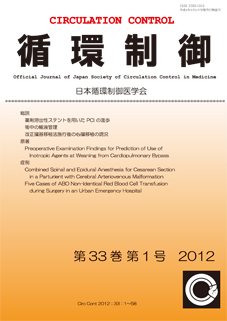All issues

Volume 33 (2012)
- Issue 3 Pages 196-
- Issue 2 Pages 88-
- Issue 1 Pages 27-
Volume 33, Issue 1
Displaying 1-3 of 3 articles from this issue
- |<
- <
- 1
- >
- >|
original articles
-
Taketo Nakamura, Ryu OkutaniArticle type: original articles
2012Volume 33Issue 1 Pages 27-31
Published: 2012
Released on J-STAGE: May 31, 2013
JOURNAL FREE ACCESSObject: Postoperative left ventricular dysfunction often occurs after cardiopulmonary bypass(CPB), requiring inotropic drug administration to achieve adequate hemodynamic status. The purpose of our study was to determine whether preoperative examination findings can predict the use of inotropic agents at separation from CPB in patients undergoing mitral valve repair without preoperative heart failure.
Methods: Patients who underwent a mitral valve repair procedure between November 2009 and November 2010 were studied. Inotropic support was defined as use of milrinone at separation from CPB, and was implemented as clinically indicated. Echocardiography and laboratory data before surgery were retrospectively examined and compared between the patients who require inotropic support(Group M) and who did not(Group C).
Results: We analyzed 33 patients who underwent a mitral valve repair procedure, 14 of whom required inotropic support. There were no significant differences in CPB time and cross clamp time, and no differences in contraction or diastolic function shown by echocardiography. However, NT pro-BNP in Group M was higher than that in Group C.
Conclusion: Elevation of preoperative NT-pro BNP, irrespective of echocardiography findings, was found to be a predictor of inotropic support at separation of CPB in patients without preoperative heart failure.View full abstractDownload PDF (201K)
case reports
-
Kodai Ikemoto, Tadahiko Ishiyama, Kazuhiro Shibuya, Yoshihide Terada, ...Article type: case reports
2012Volume 33Issue 1 Pages 32-35
Published: 2012
Released on J-STAGE: May 31, 2013
JOURNAL FREE ACCESSA parturient with intracranial arteriovenous malformation presented for elective cesarean section. Combined spinal and epidural anesthesia was employed because it could provide sufficient analgesia and could produce hemodynamic stability. She received subarachnoid block with 7.5 mg of 0.5% isobaric bupivacaine and incremental epidural boluses of 0.75% ropivacaine to a total volume of 6 ml. Intraoperative maternal hemodynamics was stable, and a healthy baby with Apgar scores of 9 and 10 at 1 and 5 min was delivered. Both the mother and baby were discharged six days later uneventfully. Spinal anesthesia with isobaric bupivacaine combined with epidural anesthesia in small incremental local anesthetic may be an applicable anesthetic alternative for cesarean section in patients with intracranial arteriovenous malformation.View full abstractDownload PDF (117K) -
Chihiro Takamatsu, Masanori Kujyo, Shotaro Sakimura, Misa Okamura, Hay ...Article type: case reports
2012Volume 33Issue 1 Pages 36-39
Published: 2012
Released on J-STAGE: May 31, 2013
JOURNAL FREE ACCESSWe experienced five cases of ABO-compatible, ABO non-identical red blood cell transfusion during emergency surgery in our hospital between April 2010 and September 2011. Although nadir hemoglobin levels were below the safety margin, prompt O-type red blood cell transfusion could save two B-type female patients. However another three patients, whose massive bleeding occurred during neurosurgery, could not be saved postoperatively.View full abstractDownload PDF (168K)
- |<
- <
- 1
- >
- >|